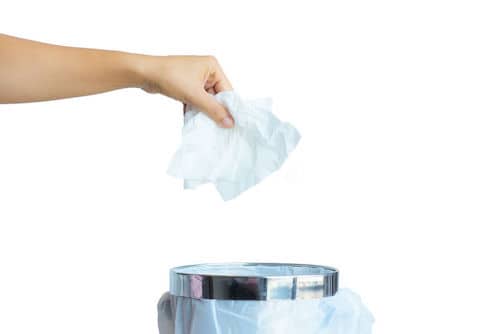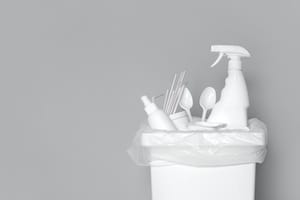 HOW TO REDUCE WASHROOM WASTE
HOW TO REDUCE WASHROOM WASTE
By now, almost all of us know and understand why we need to move towards living sustainably—and part of that is creating less waste. Reducing waste won’t only be good for the environment, it will make your life far more pleasant too.
When you empty your bathroom trash can every week, you probably see the same old junk again and again. Blunt disposable razors, empty toothpaste tubes, used floss, and empty plastic packaging seem to pile up endlessly.
However, by changing a few things you can cut down on waste radically and embrace a greener lifestyle.
HOW DO YOU REDUCE BATHROOM WASTE?
Reducing waste in the bathroom uses the same principles as reducing waste in the rest of your house. The key is being conscious of what you buy, what you use, and how you dispose of it.
A good starting point would be to take an inventory of what bathroom products you have, what your trash consists of, what products you purchase regularly, and what products have sat untouched on the shelf for months.
Sorting through your trash can be revealing, as well as surprising. You might not have realized exactly how much trash you generate, and how much packaging gets discarded with each product you buy.
Reducing waste means reducing packaging and reducing disposable products, as well as moving towards biodegradable packaging (or no packaging at all). It also means buying products you can use indefinitely, and trying to use products safe for the environment (soaps and shampoos, for example).
THE PLASTIC PROBLEM
It’s an unfortunate truth. Almost every product you buy, whatever type, comes in plastic packaging. Toothbrush, toothpaste, razors, floss, soap, shampoo… even toilet paper gets packed into a plastic bag, unless you buy one roll at a time.
Unless you have an excellent recycling system, every bit of this plastic gets thrown away and ends up in landfills—plastic that takes up to half a millennium to decompose. On top of that, not all plastic that you put into a recycling bin is recyclable. This makes reducing plastic waste a little trickier; the only effective way to tackle this issue is to avoid buying and using plastic wherever possible.
 HOW CAN I REDUCE PLASTIC WASTE IN THE BATHROOM?
HOW CAN I REDUCE PLASTIC WASTE IN THE BATHROOM?
Take stock of your trash can’s content. What plastic items or packaging are you discarding? Most products actually have more eco-friendly options. It just takes a bit more effort to find them and change your habits.
- Disposable razors
Instead of buying plastic razors only good for one use, go for something that lasts. A reusable razor with replaceable blades, an electric shaver or even a straight razor if you’re feeling sophisticated are all options.
- Plastic toothbrush
You might use your standard plastic toothbrush for a while, but to avoid adding to plastic waste you can swap your usual product for a biodegradable version. Bamboo toothbrushes are all the rage now and are just as good.
- Dental floss
If you pay attention to your dental hygiene, you probably use a fair bit of dental floss. Floss is essentially waxed nylon packaged in a plastic dispenser. Unfortunately, there are not as many options when it comes to floss, but you can get floss using silk instead of nylon. Otherwise, try to find floss that doesn’t come in a plastic container.
- Menstrual products
Disposable sanitary pads and tampons contribute hugely to plastic waste. One alternative is a reusable menstrual cup, which is both more eco-friendly and hygienic.
- Microbeads
There isn’t that much awareness of microbeads and their detrimental effect on the environment, which is exactly why it’s so important to learn how to curb their use.
Microbeads are minute bits of plastic added to many hygiene products—toothpaste, shower gels, exfoliating products, and shampoos are some examples. Although they’re invisible to the naked eye, they contribute vastly to plastic pollution in bodies of water where fish and other animals ingest them.
When you’re shopping for toiletries, make sure that you’re buying microbead-free products only.
HOW CAN I MAKE MY BATHROOM MORE SUSTAINABLE?
Apart from cutting down on plastic waste, there are several other changes you can make to lessen your impact on the environment.
By making an initial inventory of the items in your bathroom, you will see what you need and what you don’t. Getting rid of what you don’t need is an essential step in making your bathroom sustainable. The practice of making your own bathroom products is becoming more popular, including homemade mouthwash, upcycling glass jars to use as storage space, homemade shampoo and conditioner, and toothpaste.
It’s quite simple to make your own shampoo out of baking soda and water. Other steps you can take to move towards living sustainably include:
- Use two trash cans: one for trash and one for recyclables
- Install a bidet—a bit of an investment, but one that saves on waste in a big way
- Use recycled toilet paper
- Avoid single-use items such as cotton swabs/Q-Tips, cotton pads, tissues (use a handkerchief) and face wipes
- Take shorter showers to conserve water or get a low-flow shower head
- Only flush the toilet when strictly necessary
- Use natural products like vinegar and baking soda to keep your bathroom clean
- Collect gray water from showers to flush toilets or water plants
HOW CAN WE MAKE ZERO WASTE AT HOME?
This is a good question, and unfortunately as of yet there is no definitive answer. But you can take steps in the right direction.
To avoid making any waste at all, you would need to buy waste-free products, which is extremely difficult in the age of mass production. Some things you can do are buy food without plastic packaging, avoid bottled water, only use reusable shopping bags, take your own mug or bottle to coffee shops, and avoid anything that’s single-use.
CREATING A HYGIENIC WASTE-FREE ENVIRONMENT
It can be overwhelming to realize how much waste you generate. However, there are many ways to change direction and start making a positive difference in your household and for the environment.
Begin by going green in your washroom. You’ll soon see how easy it is to live more sustainably, and can then shift your focus to other areas in your home.
